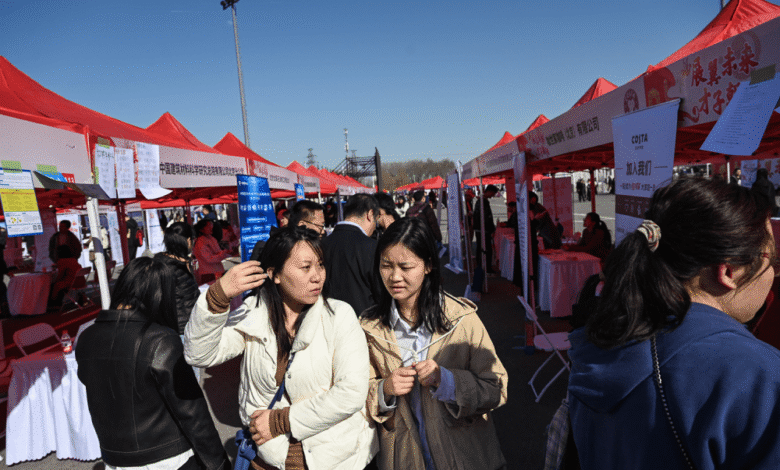China’s AI Planners Are Fearful of Job Losses

In Shanghai, young unemployed professionals pay $5 a day to sit under fluorescent lights at a “pretend to work” company, one of many fake offices around the city that offer Wi-Fi, coffee, and the illusion of employment. Possibly just a few blocks away, rural migrant workers sleep in shifts in a shared room, shifting to one job.
Both groups face the same headwinds. China’s economic slowdown and structural shifts – including the real estate collapse and the suppression of the technology sector – have left fewer jobs. And there is an even more disruptive potential force for job seekers on the horizon: artificial intelligence at scale.
In Shanghai, young unemployed professionals pay $5 a day to sit under fluorescent lights at a “pretend to work” company, one of many fake offices around the city that offer Wi-Fi, coffee, and the illusion of employment. Possibly just a few blocks away, rural migrant workers sleep in shifts in a shared room, shifting to one job.
Both groups face the same headwinds. China’s economic slowdown and structural shifts – including the real estate collapse and the suppression of the technology sector – have left fewer jobs. And there is an even more disruptive potential force for job seekers on the horizon: artificial intelligence at scale.
The Chinese Communist Party appears determined to accelerate the deployment of artificial intelligence in various sectors of the economy. The AI+ plan, released in August, sets ambitious goals: AI devices, agents and applications are expected to reach a penetration rate of more than 70% throughout society by 2027 and 90% by 2030. To observers in Washington, the AI+ plan is evidence that Beijing is intent on dominating AI development and deployment at any cost.
The reality is more complex. Beijing recognizes the pressure that AI can put on China’s already fragile labor market, and is prepared to manage the deployment of AI to limit job losses and avoid any disruptions. More importantly, the Chinese Communist Party does not see a zero-sum trade-off between achieving victory in the AI race and protecting internal stability. For Beijing, the two issues are two sides of the same coin.
The strength of the Chinese economy has always been a topic of debate, fueled by unreliable data and political uncertainty. However, across most indicators, two trends are clear. The first is high unemployment rates among youth. Official figures show that unemployment among people aged 16 to 24 who are not in school rose to 18.9 percent in August.
Behind this figure lies a structural mismatch: unprecedented waves of university graduates are entering the labor market, but sectors that once absorbed many of them, including real estate, finance, and technology, are now in decline, having borne the brunt of China’s recent economic and political transformations.
The second economic trend is the increasingly precarious situation of China’s vast unskilled workforce – hundreds of millions of rural workers who often live in cities to work. Many of them have been forced to leave jobs due to the collapse of the housing market and the outflow of low-skilled manufacturing industries. Increasing numbers of them now rely on China’s crowded gig economy, turning to ride-hailing or delivery platforms that offer little in the way of social security protections. Some of them even returned to farming in the countryside.
New graduates and low-skilled workers, already facing problems, are also most vulnerable to AI, and whose early disruptions are most likely to target entry-level white-collar work and routine manual labor. And in the US, economists recently found that young workers in jobs highly exposed to AI have seen a relative decline in employment of 13% since the launch of ChatGPT in November 2022. There is no comparable data in China, but one major recruitment website showed that job advertisements for college graduates fell by 22% in the first half of 2025 compared to the previous year.
The outlook is similarly bleak for China’s low-skilled workforce. Research suggests that embodied artificial intelligence, from robots to self-driving vehicles, is likely to replace routine manual labor, negatively impacting lower- and middle-class workers. This dynamic is already playing out in China, where delivery drones and self-driving taxis are taking to the streets (and skies) of major cities. Although the economic ramifications for freelancers have not yet been measured, public concern about job losses is rising. In Wuhan last year, driver protests against Baidu’s robotaxis captured national attention.
How will the Chinese Communist Party respond to the threat of job displacement due to artificial intelligence? On the one hand, they may be willing to accept short-term job losses as the price of progress. Beijing views AI as a strategically vital technology – a conviction reflected in the AI+ initiative but dating back to the 2017 AI Development Plan.
The Chinese Communist Party believes that artificial intelligence can address a wide range of domestic challenges, from the burden of elderly care caused by demographic decline to educational disparities between urban and rural areas, and ultimately create new forms of work. (The Ministry of Human Resources and Social Security has already recognized many new professions emerging from the development of artificial intelligence.) Moreover, the party has sacrificed employment for the sake of economic restructuring before. In the late 1990s, it broke China’s “iron rice bowl” system of guaranteeing lifelong employment for urban state workers, laying off millions in an attempt to streamline and modernize the inefficient state-owned economy.
However, there are signs that Beijing will take steps to mitigate AI-induced unemployment, even if it means managing AI adoption.
One reason for this is that China in 2025 is not the China of the 1990s. At the time, the country’s economy was expanding at rates exceeding 10%, and mass unemployment quickly gave way to labor shortages as millions of people migrated from inland provinces to coastal centers. Today, with overall growth slowing and job creation created by artificial intelligence only gradually, it will be difficult to compensate for job losses.
This does not mean that mass AI-related layoffs will send people to the streets in protest. (Some claim that digital life, including artificial intelligence itself, will numb the frustrations of young workers.) But the potential for any social unrest is of deep concern to the Chinese Communist Party and president Xi Jinping, who personally values stability above all else. Following a wave of violent attacks last year, for example, Beijing has stepped up surveillance, expanded security measures, and cracked down on critical discussions of the health of China’s economy. Moreover, the fallout from AI job losses may take more subtle but equally troubling forms: reduced consumption, escalating welfare burdens, and the potential for increased migration.
Xi belongs to a different class of Chinese Communist Party leaders, too. While his predecessors gave up job security, benefits, and broader protections for workers in exchange for rapid growth, Xi has moved in the opposite direction. Under the slogan of “shared prosperity,” he has demonstrated his willingness to rein in even some of China’s most profitable sectors, from technology and education to finance, in the name of reducing social inequality and combating social harms. For example, the country’s 2021 regulation of recommendation algorithms emerged partly in response to public anger over the harsh working conditions faced by delivery drivers, whose schedules and incomes were governed by strict algorithms that ignored the realities of mobility in Chinese cities. The regulation instructed platforms not to use the “most stringent algorithm” to assign and evaluate requests, but instead to adopt a “moderate algorithm” that alleviates time pressures.
A similar instinct may shape Beijing’s response to today’s AI job disruption. There are already early signs of official concern on this front. Although the AI+ plan was largely aimed at expanding the reach of AI, it nonetheless included a line calling for steps to “minimize impacts on employment.” During this year’s two-session meetings, one official put forward an “AI + Employment” framework that includes tax incentives, wage subsidies, reskilling programs, and even limits on the technology’s ability to displace certain jobs.
The private sector also expresses similar concerns. A DeepSeek representative made a rare public appearance this month at an industry forum, where he warned that disrupting AI could lead to a labor crisis and the eventual automation of all jobs — a process that could “shake society to its core.”
It would be a mistake to assume that Xi sees the push for AI deployment and unemployment management as contradictory. In the United States, where AI policies are centered around “winning the AI race” against China, domestic efforts to limit the downsides of AI or regulate its spread are seen as obstacles to greater geopolitical competition. By contrast, Chinese policy documents make no mention of a global “AI race.”
This omission does not indicate indifference to geopolitical competition; Rather, it reflects Beijing’s conviction that the core value of artificial intelligence lies in boosting the domestic economy and addressing domestic problems. From Beijing’s perspective, true victory then depends on directing the deployment of artificial intelligence so that it strengthens China’s economy without destabilizing its social foundations.
Don’t miss more hot News like this! Click here to discover the latest in Politics news!
2025-11-20 19:25:00




